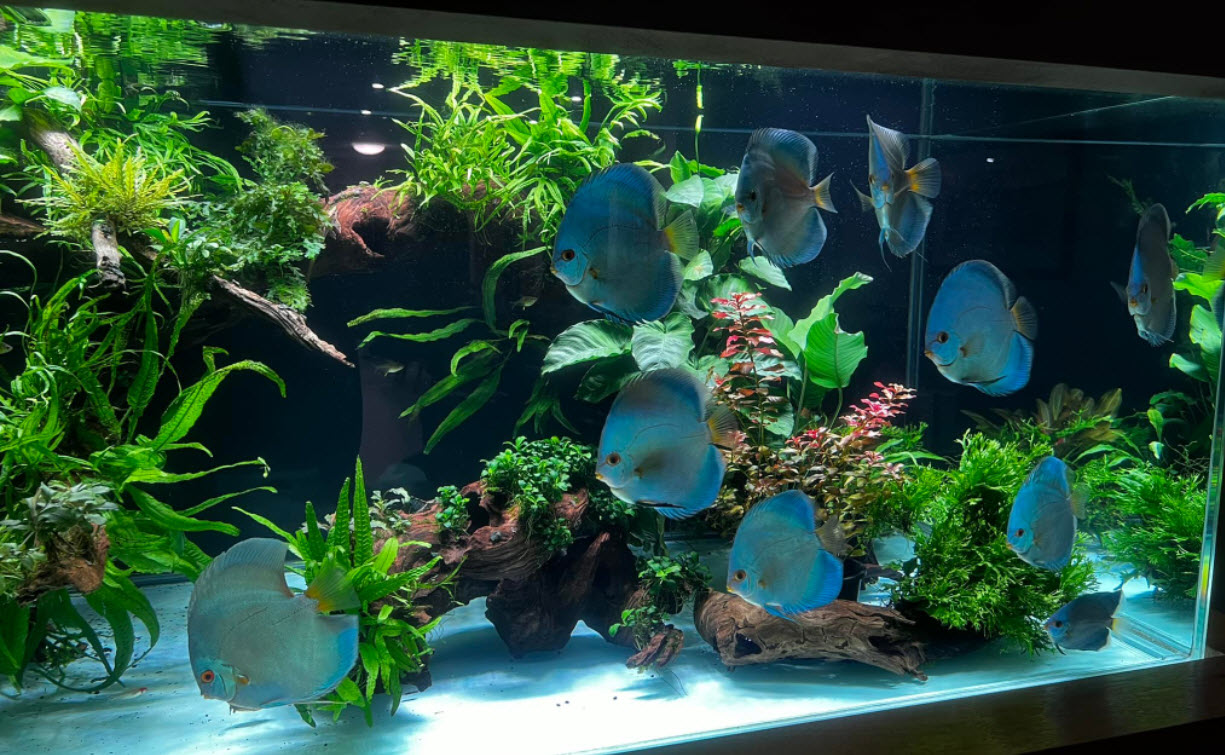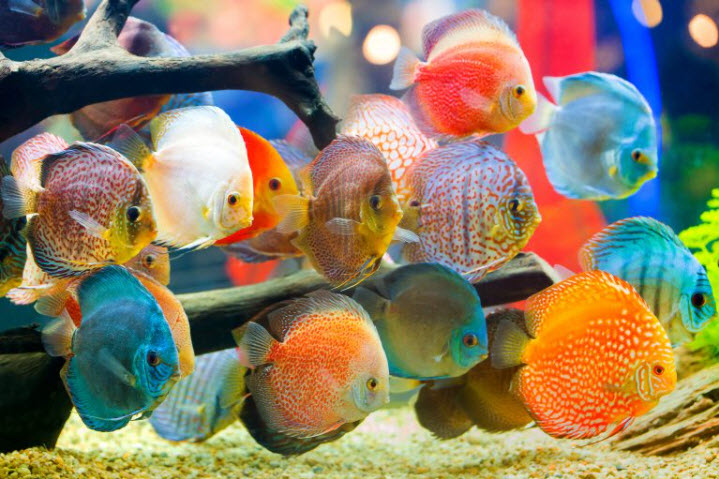
A Predicate Example
On October 1, 2023 Dan Hiteshew (Everyday Fishkeeping) posted a YouTube video entitled “Suck This, Discus Keepers”. Dan had two discus breeding in a community tank which was not treated in any special way. It had nitrates over 80 ppm. It was fed flake food. The filtration wasn’t the greatest in the world. It was a very mature 125 gallon planted community aquarium. The water was crystal clear. Temperature was 79 degrees. The only negative was that his discus were small, in the range of four inches, rather than the six inch dinner plates seen in competitive discus.
This clearly shows that all the hype about how sensitive discus are is just hype. Note that if I had to pick a reason for the small size I would pick the food. There is a lot of research on discus which says the growth rate is dependent on the animal protein level in the food. Flake food tends to be low in animal protein.

“Optimum Conditions”
The “optimum conditions” for DECORATIVE discus are:
- Crystal clear bacteria free water created by a HUGE amount of biofiltration. Cloudy or “dull” water is the enemy of all blackwater fish, including discus. This is the most important variable by far. The biofiltration should only be lightly cleaned when the flow slows down.
- Relatively slow moving water which is also well aerated (this can be challenging!).
- Adult discus do just fine with any pH from 6.5 to 8.5 and any KH and GH. It is a myth that discus need soft acid water. Another myth is that discus need the conditions they were raised in.
- The “optimum” temperature is between 780 and 820 F. (260 to 270 C.) but discus will do well in anything from 750 to 890 F. (240 to 320 C.) with occasional excursions to 700 to 950 F. (210 to 350 C.)
- Water changes need to be done ONLY to keep nitrates below 80 ppm. Well meaning “Experts” who make statements like “one must do at least 50% water changes every day with discus” are NOT correct if one has DECORATIVE discus.
- Decent quality food with at least 45% animal protein and at least 10% fat by dry weight.
- Only peaceful, slow moving tank mates
But note these are “optimums”. Very fine, healthy, attractive DECORATIVE discus can be raised well away from these optimums as long as the water is crystal clear.

Tankmates for Discus
Discus typically are kept in a species only tank. But some like some other fish in with them. Conventional wisdom is that discus only do well with schools of small tetras like the cardinal tetra. While cardinals may be fine with small juvenile discus, adults discus will enjoy eating small tetras and other small fish.
Don’t stock discus with small fish like rummy nosed tetras.
I’ve seen gourami’s, Congo tetras, angelfish, and larger rainbowfish all doing well with adult discus.
It is often surprising what probably are poor tankmate choices for a discus aquarium You want to avoid anything nippy or willing to chew (some plecoes, some barbs like the tiger barb, many livebearers, some tetras like serpae, rosy and black phantoms). Do you really want a $3 barb chewing on the fins of a $100 discus? Small cichlids like rams or appistos can be a problem as they can get quite territorial when breeding.
But be aware this are not “rules” and many keep discus in community tanks with all sorts of other fish. Just keep in mind that the further you go from the “standard” tankmates the more likely you will have issues with nipping, aggression, etc. If you decide to stray from the standards just be extra cautious and when in doubt move them out, hopefully just to another tank.

The Planted Tank and Water
Discus love well planted tanks. But this can be a challenge. Plants take carbon dioxide and produce organic compounds such as proteins and carbohydrates. Plant leaves are constantly dying and being renewed. When plant tissue dies it releases dissolved organic compounds. Dissolved organic compounds feed bacteria in the water column.
So getting healthy, crystal clear, bacteria free water in a planted tank is a challenge. Many correctly say that plants “filter the water” and remove ammonia and nitrate. What they miss is that plants add dissolved organic compounds. So plants need MORE, not less filtration, than tanks with no plants.

I find easy plants like Vallisneria, java fern or sword to be the best choice with discus. Since I use undergravel filters I put the swords and val in small pots filled with sandy soil. I use a low light low tech type set up.
Many discus owners do not use undergravel filters. They have soil based planted, low tech, low light tanks, with a layer of soil under sand or gravel (“Walstad Aquarium”). Note that expensive purchased aquarium gravels an soils “made especially for planted aquariums” are not options I would recommend. Typically these substrates only work with heavy fertilization, heavy lighting and carbon dioxide additions.

Some beginners try things like adding carbon dioxide injection to a planted discus tank. Be aware that it is VERY COMMON for carbon dioxide injectors to fail and inject too much carbon dioxide. This can easily kill a whole tank of fish. Given the price of discus, high tech carbon dioxide injection is NOT a desirable setup! A low light low tech type aquarium is a much better option. Another good option is a low tech jar CO2 system. We go over that low tech DIY system in this article:
15.6.1. Low Tech CO2 System
Discus in the wild cluster tightly in groups of about 500 individuals among the roots and branches of downed trees in the still water in lakes or slow moving rivers. They rarely venture out from these shelters, which makes collecting them somewhat challenging. This is why discus should have vertical shelter like Vallisneria, either live or plastic, in their tanks. They love lots of wood and branches in their aquariums. And discus are a very shy fish and like to be in a room which is “peaceful”. They will not do well in a child’s playroom.

Information on Discus
The following articles will be useful reading if you are contemplating keeping discus:
17.11. Discus
17.11.2. Filtration for Discus
17.11.3. Water for Discus
17.11.4. Food for Discus
17.11.5. Discus Pheromones
17.11.6. Breeding Discus
17.11.7. Discus Aquarium Photos
.
Return to Fish Selection Menu
.
Aquarium Science Website
The chapters shown below or on the right side in maroon lead to close to 400 articles on all aspects of keeping a freshwater aquarium. These articles have NO links to profit making sites and are thus unbiased in their recommendations, unlike all the for-profit sites you will find with Google. Bookmark and browse!
.
